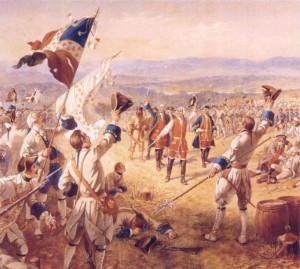Chapter 11, “The Cherokee War and the Indirect Challenge to the Carolina Gentry” covers the constant power struggle between British and American authorities. The power struggle and assumption the British authorities had that South Carolinians were “backwards colonials” interfered with the ability to protect the colony during the war (Weir 265). After a dispute with William Wragg, William Henry Lyttelton, who was appointed the new Governor in 1755, suspended Wragg from council, which was just the beginning of his long line of mistakes. After a quartering issue with the troops, Lyttelton sought to resolve the confrontation between colonial and regular troops by leading 2,000 men on a voyage against Fort Toulouse. Being tied up in Canada, the British officials could not approve Lyttelton’s mission. Meanwhile, the Cherokee Indians were growing more and more upset with the British because their land was being intruded on. After a dispute with the Indians, Lyttelton prohibited all trade with the tribe, which resulted in the Indians’ attack on North and South Carolina. As Lyttelton prepared for a war, the chief arrived in search of peace. Lyttelton was advised to hold the chief hostage, but refused. Once conditions became so bad he was forced to hold hostages while signing a treaty that the Indians would surrender the men who had raided the settlements. Soon after the treaty fell apart and the Indians attacked Fort Prince George, where Lyttelton was holding the hostages. It was deemed the “unlucky affair” of the hostages because the soldiers quickly “butchered” them (Weir 270).
Immediately, Lyttlelton sought help from British commander, Colonel Archibald Montgomery, who believed “the Indians were more sinned against than sinning” (Weir 270). Montgomery and his troops swarmed the Indians’ towns, burning it all down. Once again, the Indians attacked, getting their revenge for the situation with the hostages. Another helping hand, James Grant, came to aid Montgomery after the attack. After Grant torched down the Indians’ villages and crop fields, a preliminary peace treaty was signed by the Indian delegation (272). The dispute over this document was Article I, which stated that four of their men must be executed, which the Indians did not agree with because they believed it would be recognizing their defeat. At this point, Grant and Montgomery were both thought to be doing a poor job, and as Weir states, Grant was thought to have “robbed Carolinas of victory” (273).
Once things with Grant settled down, the Indians agreed to surrender some land in the treaty of 1761, which set boundaries between Indians and settlers. White settlers controlled most of Carolina’s backcountry, consisting of almost three quarters of South Carolina’s population. After a series of robberies, the Regulators were established to control the outlaw activity.
The power struggle between the settlers and the British officials continued. “Pre-Revolutionary controversy”, as Weir terms it, included issues on the judge’s tenure of office, South Carolinians being replaced on the bench, and the unhappiness the men of the low-country had with British actions. The main issue became the British ego, constantly reminding South Carolinians that British officials were always superior to South Carolinian ones. The British officials believed South Carolina’s to be “too new” and unable to deliver the proper respect (Weir 287). The Chapter summarizes the criticism South Carolina received from the British, instead of the admiration and applause they felt they deserved.

Comments are closed.